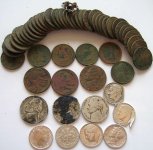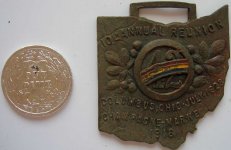Captn SE
Silver Member
- Apr 1, 2007
- 2,774
- 13
- Detector(s) used
- Minelab Explorer SE; X-1 Target Probe; Pro Coil, 6x8 SEF, Coiltek Platypus Elliptical, Sunray X8, Expl. 1050 coils
Hello Everyone,
A small group of us here in S. CA have been pounding an extremely productive area of an old park, and having an awesome time over the past two weeks. All I can say is that it has been the most productive area for old coinage in a park that I've ever hunted.
It's now safe to say that most of the coins have been recovered from this area already. Probably still a few stragglers left to find, maybe even a gold coin. The "Magnificent 7" (and you all know who you are) have done a great job at recovery. I would love to get a rough count of the numbers of silvers/injuns/V's/Buffalos we've recovered from this small area.
Probably still a few stragglers left to find, maybe even a gold coin. The "Magnificent 7" (and you all know who you are) have done a great job at recovery. I would love to get a rough count of the numbers of silvers/injuns/V's/Buffalos we've recovered from this small area.
Below is my latest finds from Tuesday's hunt from "The Spot". I ended up with another barber, an '06S Dime(that's my 6th from this spot), in addition to 4 more Injuns ('07(3), '06, making my 14th Injun from this one site). Also got another first for me, 3 War Nickels in one hunt. Two of them sounded like a zinc penny, while one sounded like a regular nickel. Trying to center on the low conductors on Tues., I ended up with 2 Buffalos (a teens, and a '35), in addition to a pre-wartime Jefferson, a 1940. I also threw in a couple of silvers I found yesterday at another area of the park, in addition to a silver Mickey ring. Lastly, on yesterday's finds was something very unexpected, which was found in someone's previous plug in the park (I won't say whose plug it was.. ). It turned out to be a cool watch Fob dating 1928. After doing some further research, I found out it was to commemorate the 10 year reunion for the A.E.F's 42nd "Rainbow" infantry division of the World War I battle of the Champagne-Marne Offensive, July 15-18, 1918. I've included a little history on this battle below. I'm really liking this Fob now!!!
). It turned out to be a cool watch Fob dating 1928. After doing some further research, I found out it was to commemorate the 10 year reunion for the A.E.F's 42nd "Rainbow" infantry division of the World War I battle of the Champagne-Marne Offensive, July 15-18, 1918. I've included a little history on this battle below. I'm really liking this Fob now!!!
Thanks everyone for looking and Happy Hunting!!
CAPTN SE
Dan
Champagne-Marne, 15 - 18 July 1918
In the four great offensives from 21 March to 13 June 1918 the Germans gained considerable ground, but failed to achieve a decisive advantage at any point on the front. Furthermore, success was bought at a price in manpower and material which they could ill afford. Their more than 600,000 casualties were irreplaceable, whereas the Allied loss of some 800,000 men was soon more than compensated for by new American units arriving at the front in ever-mounting numbers. By July 1918 Allied troops outnumbered German on the Western Front. Other factors also contributed to the decline of German morale, notably the pinch of the blockade and the effectiveness of the Allied propaganda, which was distributed widely by air at the front and in German cities behind the lines. But Ludendorff refused to consider peace negotiations, and planned two more offensives for July which he hoped would bring victory. The first of the new drives was designed to capture Rheims, to make more secure the supply of the Merge salient, and to draw in Allied reserves. The second and larger offensive, destined never to be launched, would strike once again at the British in Flanders. When the two-pronged German assault on either side of Rheims began on 15 July the Allies were prepared for it. Plans for the attack had leaked out of Berlin, and Allied airplanes had detected the unusual activity behind the enemy front. Foch had time to draw up reserves, and Petain, the French commander, skillfully deployed his troops in defense-in-depth tactics. Consequently the German drive east of Rheims fell far short of its objective. The attack west of the city succeeded in pushing across the Marne near Chateau-Thierry, but was checked there by French and American units. Among the A.E.F. units involved in this action were the 3d, 26th, 28th, and 42d Divisions, the 369th Infantry Regiment, and supporting elements (in all about 85,000 Americans). It was here that the 38th Infantry of the 3d Division gained its motto, "Rock of the Marne."
By 17 July the Champagne-Marne offensive had petered out and the initiative passed to the Allies. The German people had built up great hopes for the success of this Friedensturm (peace offensive); its failure was a tremendous psychological blow to the whole nation.
A small group of us here in S. CA have been pounding an extremely productive area of an old park, and having an awesome time over the past two weeks. All I can say is that it has been the most productive area for old coinage in a park that I've ever hunted.
It's now safe to say that most of the coins have been recovered from this area already.
 Probably still a few stragglers left to find, maybe even a gold coin. The "Magnificent 7" (and you all know who you are) have done a great job at recovery. I would love to get a rough count of the numbers of silvers/injuns/V's/Buffalos we've recovered from this small area.
Probably still a few stragglers left to find, maybe even a gold coin. The "Magnificent 7" (and you all know who you are) have done a great job at recovery. I would love to get a rough count of the numbers of silvers/injuns/V's/Buffalos we've recovered from this small area.Below is my latest finds from Tuesday's hunt from "The Spot". I ended up with another barber, an '06S Dime(that's my 6th from this spot), in addition to 4 more Injuns ('07(3), '06, making my 14th Injun from this one site). Also got another first for me, 3 War Nickels in one hunt. Two of them sounded like a zinc penny, while one sounded like a regular nickel. Trying to center on the low conductors on Tues., I ended up with 2 Buffalos (a teens, and a '35), in addition to a pre-wartime Jefferson, a 1940. I also threw in a couple of silvers I found yesterday at another area of the park, in addition to a silver Mickey ring. Lastly, on yesterday's finds was something very unexpected, which was found in someone's previous plug in the park (I won't say whose plug it was..
 ). It turned out to be a cool watch Fob dating 1928. After doing some further research, I found out it was to commemorate the 10 year reunion for the A.E.F's 42nd "Rainbow" infantry division of the World War I battle of the Champagne-Marne Offensive, July 15-18, 1918. I've included a little history on this battle below. I'm really liking this Fob now!!!
). It turned out to be a cool watch Fob dating 1928. After doing some further research, I found out it was to commemorate the 10 year reunion for the A.E.F's 42nd "Rainbow" infantry division of the World War I battle of the Champagne-Marne Offensive, July 15-18, 1918. I've included a little history on this battle below. I'm really liking this Fob now!!! Thanks everyone for looking and Happy Hunting!!
CAPTN SE
Dan
Champagne-Marne, 15 - 18 July 1918
In the four great offensives from 21 March to 13 June 1918 the Germans gained considerable ground, but failed to achieve a decisive advantage at any point on the front. Furthermore, success was bought at a price in manpower and material which they could ill afford. Their more than 600,000 casualties were irreplaceable, whereas the Allied loss of some 800,000 men was soon more than compensated for by new American units arriving at the front in ever-mounting numbers. By July 1918 Allied troops outnumbered German on the Western Front. Other factors also contributed to the decline of German morale, notably the pinch of the blockade and the effectiveness of the Allied propaganda, which was distributed widely by air at the front and in German cities behind the lines. But Ludendorff refused to consider peace negotiations, and planned two more offensives for July which he hoped would bring victory. The first of the new drives was designed to capture Rheims, to make more secure the supply of the Merge salient, and to draw in Allied reserves. The second and larger offensive, destined never to be launched, would strike once again at the British in Flanders. When the two-pronged German assault on either side of Rheims began on 15 July the Allies were prepared for it. Plans for the attack had leaked out of Berlin, and Allied airplanes had detected the unusual activity behind the enemy front. Foch had time to draw up reserves, and Petain, the French commander, skillfully deployed his troops in defense-in-depth tactics. Consequently the German drive east of Rheims fell far short of its objective. The attack west of the city succeeded in pushing across the Marne near Chateau-Thierry, but was checked there by French and American units. Among the A.E.F. units involved in this action were the 3d, 26th, 28th, and 42d Divisions, the 369th Infantry Regiment, and supporting elements (in all about 85,000 Americans). It was here that the 38th Infantry of the 3d Division gained its motto, "Rock of the Marne."
By 17 July the Champagne-Marne offensive had petered out and the initiative passed to the Allies. The German people had built up great hopes for the success of this Friedensturm (peace offensive); its failure was a tremendous psychological blow to the whole nation.
Amazon Forum Fav 👍
Attachments
Upvote
0















